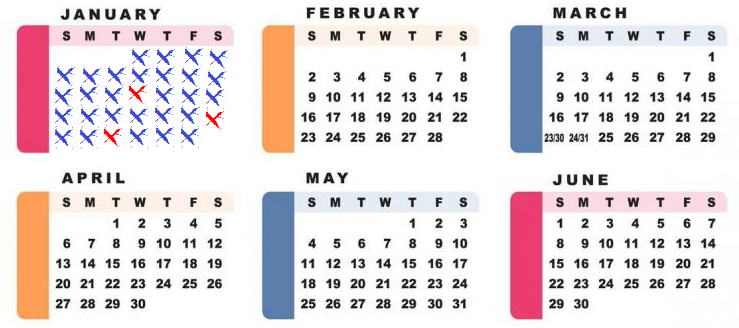Forge the Almighty Study Chain

The Study Chain System is designed around the concept that missing one day (of studying, for example) makes it much more likely that you will miss two days. Missing two days makes it more likely that you'll miss three days. Missing three days makes it likely that you'll give up completely.
The general idea is that you buy or print a monthly or annual calendar, and each day you have a few recurring tasks that you must do. And if you manage to complete all of the required tasks for a day, then you put a big (blue) X over that day in your calendar. For example, if today were January 12, you'd want your calendar to look like this:

The motivation here is that you don't want to break that chain of X's. Something about the OCD nature of humans seems to make this more motivating.
Deciding Your Chain Requirements
In past versions of this course, I used to recommend that we put an "X" on our calendars when we completed three tasks in one day:
- Flashcards
- Listening Practice
- Grammar and/or Speaking Practice
For example, if you completed all of your Anki flashcards, listened to some shadow loops (or even a podcast episode about Japanese), and spent a few minutes reading about Japanese grammar (or took a face-to-face lesson with a teacher), then you could put an "X" on your calendar.

Maybe I'm just not as good of a student as I used to be, but that seems like a pretty massive requirement for us to do all of those things every single day. It would also be fine to just make your requirements be "complete all Anki flashcards due for review." Then you would only need to do 1 think every single day, which is a bit less intimidating, and perhaps a bit more realistic.
Ultimately, it's your decision. A second option is to have different-colored X's for different types of accomplishments. For example, you could write a blue X if you (1) completed your flashcards, (2) listened to some shadow loops, and (3) studied a bit of grammar in a day. And you could put a red X if you only did your flashcards:

When taking this approach, a red X is not such a big deal. In other words, you give myself a pass for slipping up one day. Nothing more than a small slap on the wrist—that hideous red on your beautiful ocean-blue chain of X's. However, if you did nothing at all, the day on the calendar would have no X at all, like February 15, below:

Another option is to use red X's when you miss a single day of studying, but no X at all if you miss two consecutive days of studying.
If you were following this approach, then the red X on February 14th (Valentine's Day) would signify that you did not study at all. Maybe you have a very demanding lower, so you didn't get a chance. Or maybe you drank yourself into a lonely stupor and forget to study. Or any excuse you want. Then, even worse, you didn't study February 15th either. So the 15th gets no X at all!! *Failure* *Pain* *Disgrace*
Cheating the System
I say that you should study Japanese every single day without exception. That is, you should still be doing your flashcards on weekends, holidays, when you're sick, busy, depressed — every day. There is one small issue with this: We're all going to fail at it eventually.
Accordingly, it can help to have a bit of leeway, a way to cheat and miss a day of studying but still get that X on your calendar (the red one, at least).
One way to do this is to use the "Review Ahead" feature in Anki. If you know that a busy weekend is coming up, for example, then on Friday, after you have completed all of your flashcards for that day, Anki will give you the option to have a "Custom Study" session, during which you can choose to "Review Ahead," like so:

If you review ahead for 2 days, for example, then Anki will not require you to review any flashcards tomorrow or the next day. Since you technically studied what you were supposed to study on those days, however, it would be OK to put an X on your calendar.
The Almighty Study Chain is meant to be a kind of reward system. Each day's small amount of studying is building to something grand and magnificent: Total fluency.
But it's hard to keep that vision in mind. We humans are weak creatures, prone to favoring immediate wants over future wants. I'm going to start studying tomorrow. I'm going to start losing weight on New Year's Day. Goals like these are fun, because we get to imagine ourselves achieving them without actually doing anything right now. Then, a year later, we end up in the same spot we were in before… and it sucks!
We can beat this by rewarding ourselves with those X's on our calendar, by building a chain. And as the chain of blue X's (or whatever color you choose) grows, you will really start to appreciate the magnificence of what you're doing. That's why I like the idea of doing this with an annual calendar, like the one above. It can really help you to visualize just how much work you've put into this endeavor, and after a while of consistently performing, just looking at a long string of Blue X's will be motivating all on its own.
If you can just build a long chain of items, you are guaranteed fluency. It's okay if a few red X's pop up here and there, but as long as you don't see any numbers, everything is okay in the world.
|
Assignment:
|
Noticed any typos we've missed or other issues?
Report them here at this link.
Have questions about something in this lesson? Something not quite clicking yet? Join our discord community and discuss any questions / comments with us and fellow students.
You can join by heading to this link.